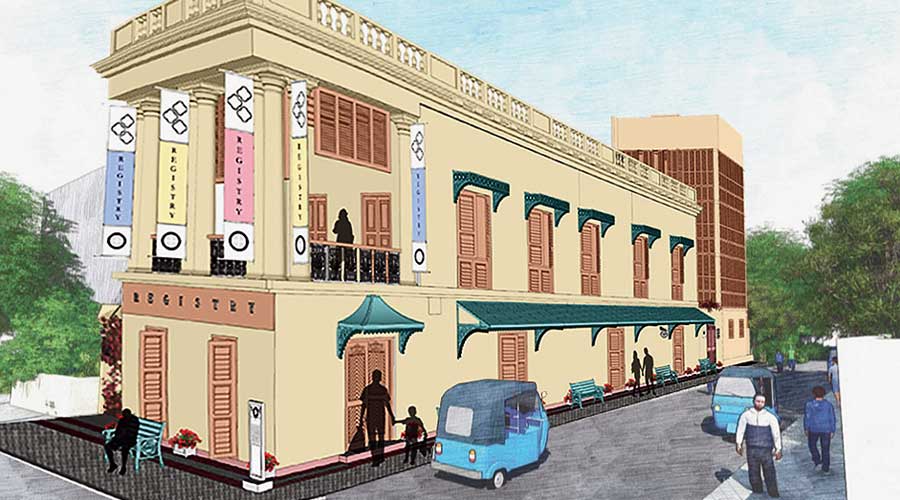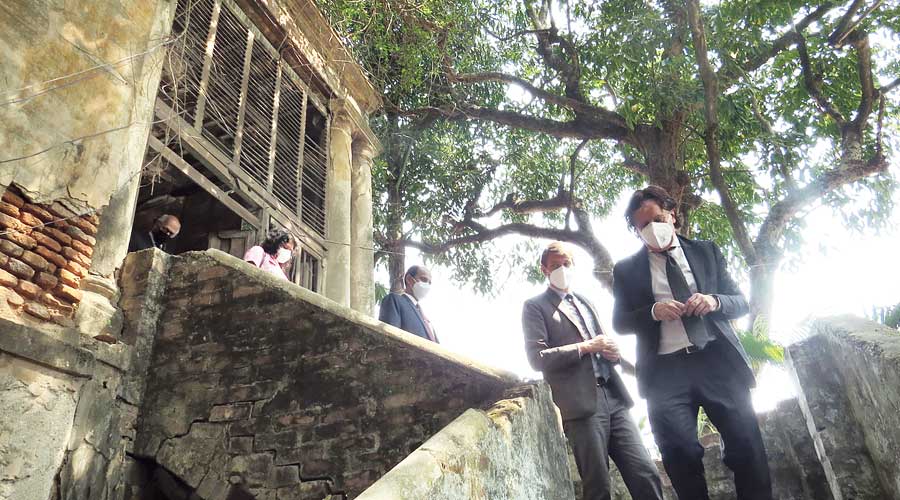An agreement which was signed between the state tourism department and the French embassy in February 2019 on the restoration and adaptive reuse of a building that stands as a crumbling witness to the colonial legacy of Chandernagore in Hooghly district moved closer to implementation with the engineers holding their first on-site meeting on Thursday.
The Registry Office, built in 1875 as a part of the first French court house in India, stands at the head of the Strand. The two-storeyed structure, held in tight embrace by a banyan tree, had been declared a condemned building in 1994. But it has been on a revival route ever since the French evinced interest in preserving a piece of its presence in the riverside town. It received a blue plaque as testimony to its importance from the state Heritage Commission in 2019.
The project will be funded and implemented by the state government while France will provide technical expertise.
At the meeting, the French side was led by consul general Didier Talpain and included structural engineers and a conservation architect, who presented the latest detailed project report. The state government side had special secretary, tourism, Shanta Pradhan, Chandernagore Municipal Corporation commissioner Swapan Kundu and his team, and engineers from Kolkata Metropolitan Development Authority.
The restored structure will house a tourist information centre, a shop, a library and a co-working space where people can bring their own devices and work.

An artist’s impression of the restored Registry Office building
A dilapidated portion at the back, delinked from the main structure, will be demolished to make space for the new building. With a cafe, a boutique hotel with six rooms and a multi-purpose space, it will have modern services like heating and plumbing but its latticed façade will be inspired by the architecture of the original edifice, said conservation architect Aishwarya Tipnis, the co-lead of the French technical expert team.
“The idea is to make it not just for tourists but for the local community. This project is based on the wishes of the people,” said the director of the French Institute in India Emmanuel Lebrun- Damiens at the meeting. The uses to which the buildings will be put are based on the findings of a public survey done across Chandernagore to identify lacunae in the town’s facilities. He pointed out that the outcome of the project would influence renovation projects in both India and France, urging the team to take up the challenges in restoration rather than take the easy way out.
Kundu spoke of the town’s emotional attachment with the project, which is expected to have a strong cultural impact.
Tipnis underlined the design principles to be followed. “It will be sustainable, so all historic materials, like doors, windows, frames, louvres and shutters, will be salvaged and reused. To reduce weight, cast iron will be used instead of concrete. Neither will services like wash rooms be added to the old structure,” she said.
After doing soil tests and checking on its verticality, the next step would be to secure the building with scaffolds before the monsoon. “We will do emergency stabilisation work to ensure it does not collapse before the actual restoration happens,” said Tipnis. The team hopes to start by April.
“It’s my first visit to Chandernagore. I knew that the building was not in good condition and that is why it took so long to start the project. Now we are in the final stages before the ground work begins. In two years, we hope it will be finished and a romantic dream that this project is for us will finally be realised,” said Talpain.
“The MoU signed was about bringing the Strand back to its grandeur and this project will be the first step to that. It will contribute to the local economy too. We chose this building as a pilot because of its locational importance and since it is in the worst condition that a building can be in. If it can be resurrected then it would hold out hope to other heritage structures,” Tipnis added.
